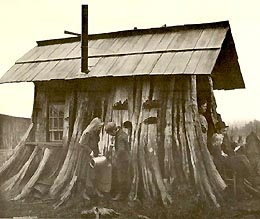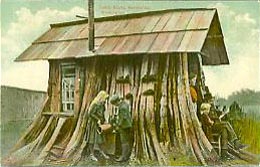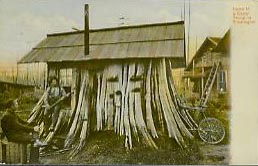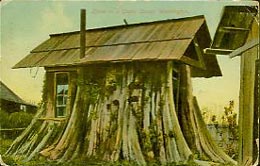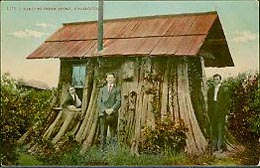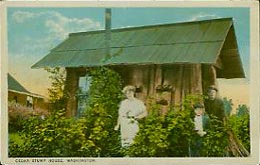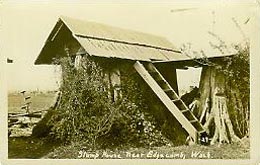This slide show presents the vintage postcard and stereoview card collection of Peter Blecha on the famous and curious Stump House located in Snohomish County within what is now Arlington city limits. The slide show was written and curated by Peter Blecha and funded by the Snohomish County Community Heritage Program.
Logs, Lumber, and Stumps
As the first waves of loggers swept over great portions of the Pacific Northwest's old-growth forests in the second half of the nineteenth century, those men opened up the dark dense woodlands to settlement. And they surely left their mark on the land. Extracting massive logs that were skidded away by oxen or floated down rivers to sawmills, the best wood was highly prized. Left behind was a scarred landscape, scrap wood, and stumps. Many stumps. Huge stumps. Stumps that still stood a full 10 feet high but were undesirable as lumber because they tended to swell down toward their base, making the wood-grain uneven.
When subsequent waves of pioneer settlers came on through, they found those old logging sites to be welcome clearings that hinted at possible futures as rich farmland. But, being littered with debris -- and those towering stumps -- these homesteads presented the challenge of years' worth of hard labor just to clear -- by burning and digging-out stumps -- enough proper space to plant orchards or raise crops or livestock.
For select stumps would-be farmers found other uses: A few of the largest were leveled off and fashioned into platforms where "stump dances" were held to the driving tones of fiddles and mandolins. But another use for stumps -- perhaps a less frivolous one -- would be discovered. By constructing roofs on them -- and attaching a door or gate -- the stump-based shelters worked fine as storage sheds or chicken houses, or pens to keep pigs and calves safe from prowling predators including raccoons, bobcats, or bears. And sometimes it was people who were the denizens of these stump houses…
Home Sweet Stump
Tree stumps have long served as temporary shelter for road-weary travelers seeking rest or escape from inclement weather. Moving into one as an actual residence is a whole 'nother matter. As early as 1847 the pioneering McAllister family -- who had initially settled on Bush Prairie (south of Tumwater) -- moved northward to the Medicine Creek area (near Nisqually). It was there that they set up shelter by hollowing out a stump and making a "Home Sweet Home" there until they could erect a proper house. After that, the structure served them as a barn.Later, on June 20, 1892, a William D. McDonald opened up the very first U.S. Post Office located in the remote northern portion of the Olympic Peninsula. The McDonald Post Office was located at a site 10 miles southwest of Port Angeles, and on the east side of the Elwha River. It was located in a large roofed stump. In time the house was sold, moved, renamed the Elwha Post Office. Today the aging icon still stands.
Edgecomb Stump House
But the most famous of all local stump houses was one located on the Lennstrom family's property in Snohomish County's Stillaguamish Valley -- in the tiny community of Edgecomb, which is currently a neighborhood within the old logging and railroad town of Arlington. Gustav Erik Vilhem (Pettersson) Lennstrom (1861-1917) was a Swedish emigrant who came to America in 1988, and soon made his way from New York to Tacoma. His bride, Brita Charlotta (nee Westerlund) Lennstrom (1864-1926), was also an emigrant as was her brother, Johan "John" Axel Westerlund (b.1880), who joined them out west.
The Lennstroms bore three children -- two born in Tacoma: Nannie Elvira Lennstrom (1892-1980), and Axel William Lennstrom (1893-1971). The family then moved northward to Edgecomb where their third child -- Hildur I. Lennstrom (1897-1927) was born. A century later Axel's son, Henry Lennstrom (b. 1924), told The Seattle Times:
"Gustav was my grandfather. When he came to this country, he made a beeline for the Pacific Northwest; there were people from Sweden that he knew. My grandfather bought this acreage at Edgecomb, a stump farm. It had been logged off but the stumps still stood. It was not land that you could cultivate. About all you could do was raise dairy cattle. And that's what he made a living at."
Westerlund -- who back in Sweden had worked as a cabinet-maker -- took on the task of hollowing out one particularly robust (22-foot-diameter) cedar-tree stump, and Gustav finished up by putting a roof, window, and door on the stump house. A stovepipe through that roof hints at the woodstove inside that kept the family warm for a few months until a conventional house was built nearby. Even after they moved into that new home, Westerlund maintained his quarters in the stump as he liked the independence and privacy it provided.
Photo Op
It was likely in 1901 that the first of many curious visitors toting a camera arrived and documented the stump house in photographs. The Northwest's famed photographer, Darius Kinsey (1869-1945), brought four cameras (of different formats) and took eight classic shots. Over the ensuing two decades they were marketed as postcards and stereoview cards and helped establish the stump house as a regional icon. Kinsey himself liked the stump house so well that by March 1902, he was using a small image of it on his company's business stationery.
In 1903 the Skagit County Times newspaper up in Sedro-Woolley, Washington, offered this description of the stump-house:
"Inside it is one good-sized room, which is boarded up and neatly papered and made as comfortable as any apartment could possibly be made. The walls inside slant inward at the top, which gives one the impression rather that it is an upstairs room, otherwise it is not different from any other room."
Upon his death in 1917, Gustav was buried in the nearby Arlington Cemetery. As Henry Lennstrom recently recalled: "After Gustav died, my father and his mother they wanted to sell the property and they wrote letters to politicians and agencies to say 'Come and preserve this very important item'" (Lennstrom interview, 2010).
But their pleas about the stump house fell on deaf ears. Instead, the property sold around 1920 and the Avondale Farm Company (which raised Holstein and Guernsey cattle, Hampshire sheep, and Wm. Leghorn chickens) began operating on the old homestead. On September 17, 1920, Avondale received a letter from the Commercial Club in Marysville requesting that the stump house be donated as a feature for a new park. Company President, Wm. E. Sander responded on September 20. He said that he wished them the best with their plans but he would need more time to think things over as "we have some thought of beautifying our place, in which case, this Stump House might be made very attractive where it is" (Sander).
Two months later Sander wrote again informing that: "My inclination is to give you this souvenir for your park, but the family that live on the place sort of hate to have it removed. The next time I'm up there I will have a talk with them (Sander, November 22). That talk apparently led to decisive action: two months later Sanders wrote again to say that: "I have recently sold the farm at Edgecomb, on which the Stump House is located, to Mr. Rasmus Konnerup. I had advised him that I had given this Stump House to your Commercial Club, and Mr. Hansen who was managing the farm for me and is now managing it for Mr. Konnerup, also knows of this part of the transaction. It may be well, however, for you to remove the Stump House soon, as I do not know what Mr. Konnerup's plans may be" (Sander, January 27).
The stump house was then disassembled -- sawing it into vertical segments, each being carefully numbered so that it might be reassembled one day for public display. Alas, that never happened. By the 1930s those stored wooden pieces had been so damaged by rodents and insects that the whole pile of remains was torched.
Memories and Postcards
Today all that remains is memories and countless postcards of the iconic abode. The original site (described on an old deed, according to Henry Lennstrom as: "The North half of the Northwest quarter of Section 27 Township 31 North Range 5 East W. M.") is notable mainly as an indistinct spot opposite the southeast corner of what is now the Arlington Airport.
Luckily, one publicly accessible vintage stump house still remains in the area. It was one that had originally been built in a huge Western Red Cedar stump by an area farmer named Joseph Kraetz. It was later sold and moved a couple times -- since 1923 it has been an attraction at the Stillaguamish Valley Pioneer Museum (20722 67th Avenue NE) in Arlington.
And the novelty of stump houses still retains attraction for many people. Indeed, from January through June, 2003, the Edmonds Historical Museum (118 15th Avenue N.) mounted an exhibit -- "Home Sweet Home: Living in a Stump House" -- that was graced by a visit from the now elderly son of Axel, Henry Lennstrom.
